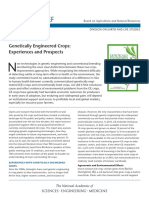Professional Documents
Culture Documents
Sea-Level Rise For The Coasts of California, Oregon, and Washington
Original Title
Copyright
Available Formats
Share this document
Did you find this document useful?
Is this content inappropriate?
Report this DocumentCopyright:
Available Formats
Sea-Level Rise For The Coasts of California, Oregon, and Washington
Copyright:
Available Formats
Sea-Level Rise for the Coasts of California, Oregon, and Washington: Past, Present, and Future
As more and more states are incorporating projections of sea-level rise into coastal planning efforts, the states of California, Oregon, and Washington asked the National Research Council to project sea-level rise along their coasts for the years 2030, 2050, and 2100, taking into account the many factors that affect sea-level rise on a local scale. The projections show a sharp distinction at Cape Mendocino in northern California. South of that point, sea-level rise is expected to be very close to global projections; north of that point, sea-level rise is projected to be less than global projections because seismic strain is pushing the land upward.
In compliance with a ny significant sea-level 2008 executive order, rise will pose enorCalifornia state agencies have mous risks to the been incorporating projecvaluable infrastructure, develtions of sea-level rise into opment, and wetlands that line their coastal planning. This much of the 1,600 mile shorestudy provides the first line of California, Oregon, and comprehensive regional Washington. For example, in projections of the changes in San Francisco Bay, two intersea level expected in national airports, the ports of California, Oregon, and San Francisco and Oakland, a Washington. naval air station, freeways, housing developments, and Global Sea-Level Rise sports stadiums have been built on fill that raised the land Following a few thousand level only a few feet above the years of relative stability, highest tides. global sea level has been The San Francisco International Airport (center) Sea-level change is linked and surrounding areas will begin to flood with as rising since the late 19th or little as 40 cm (16 inches) of sea-level rise, a to changes in the Earths early 20th century, when value that could be reached in several decades. climate. A warming climate global temperatures began to Image courtesy Bay Conservation and causes global sea level to rise increase. The most compreDevelopment Commission principally by (1) warming hensive assessments of global the oceans, which causes sea sea-level rise come from the water to expand, increasing ocean volume, and Intergovernmental Panel on Climate Change (2) melting land ice, which transfers water to the (IPCC). Based on tide gage measurements from ocean. However, at regional levels, sea-level rise is around the world, the IPCC estimated that global affected by a number of additional factors. On the sea level rose an average of about 1.7 mm per year U.S. west coast, factors include regional climate over the 20th century. Over the past 20 years of the patterns such as El Nio, which warm and cool the century, precise satellite altimetry measurements Pacific Ocean; the rising and sinking of land along and tide-gage records show that the rate of sea-level the coast as a result of geologic processes such as rise increased to about 3.1 mm per year, and it is plate tectonics; and proximity to Alaska glaciers, projected to rise at an even faster rate in the future which exert a gravitational pull on sea water. (Figure 1).
Figure 1. Observed and projected sea-level rise. After a few thousand years of relative stability, sea level began to rise along with global temperatures beginning in about 1900, as measured by tide gages (red line) and satellite altimetry (blue line). Projections of sea-level rise to 2100 in dark pink are from the IPCC and are based on global climate models that estimate the individual contributions to sea-level rise. Projections in gray are from Vermeer and Rahmstorf and are based on the observation that sea level rises faster as the Earth gets warmer. The projections from this report (right, beginning at a zero in the year 2000) fall between the two.
However, different projection approaches yield very different estimates. The IPCC projects sea-level rise using computer models (Figure 1, dark pink). An alternative approach is based on the observation that sea level rises faster as the Earth gets warmer (Figure 1, gray). Neither method accounts fully for the rapid changes in the behavior of ice sheets and glaciers that have been observed recently (see Box 2). The global sea-level rise projections in this report, which use models and extrapolations of historical trends and account for rapid changes in ice behavior, fall between those two estimates.
Sea-Level Rise in California, Oregon, and Washington
Sea level is not uniform everywhere and is continually changing. A number of natural processes affect sea level at any given place and timefrom tides that produce hourly changes to tectonic forces that take place over millions of years. Along the coast, sea level is measured relative to the land. Thus, factors that affect both ocean levels and land levels must be considered in projections of regional sea-level rise.
the ocean, and the land and ocean basins rise or sink (deform) as a result of this loss of land ice mass. These effects produce a distinct spatial pattern of regional sea-level change commonly referred to as a sea-level fingerprint. Ice in Alaska, Greenland, and Antarctica has a significant effect on the ocean in the northeast Pacific Ocean. The gravitational and deformational effects of melting from these three sources reduces the rate of relative sea-level rise, especially in northern Washington. The melting and eventual disappearance of the ancient North American ice sheets has a different impact on sea-level rise that varies by location. The land is rising about 1 mm per year in northernmost Washington, which had been covered by an ice sheet; the land rise causes relative sea level to fall. However, in areas at the margins of the ice sheet and beyond, which includes the rest of Washington, Oregon, and California, the land is sinking about 12 mm per year, causing relative sea level to rise. Human activities can have a significant effect on land height at the local level. For example, the extraction of water or hydrocarbons from under ground can lower surface elevations up to tens of centimeters per year if
Box 2. Contribution of Melting Land Ice to Sea-Level Rise. Since 2006, the ice loss rate from the Greenland Ice Sheet has increased, and, according to most analyses, the contribution of the Antarctic Ice Sheet to sea-level change has shifted from negative (lowering sea level by accumulating ice) to positive (raising sea level). Ice loss rates from glaciers and ice caps have declined over the same period, but not enough to offset the increases in ice sheet melt. Melting land ice is now the largest contributor to global sea-level rise.
Regional Factors Affecting Ocean and Land Levels Along the west coast of the United States, climate patterns such as the El NioSouthern Oscillation affect winds and ocean circulation, raising local sea level during warm phases (El Nio) and lowering sea level during cool phases (La Nia). Large El Nio events can raise coastal sea levels by 10 to 30 cm (4 to 12 in) for several winter months. The large mass of glaciers and ice sheets creates a gravitational pull that draws ocean water closer. As the ice melts, the gravitational pull decreases, ice melt enters
fluids are not returned; however, these effects are too local to affect regional projections. The most significant effect on regional land levels results from plate tectonics. Washington, Oregon, and northernmost California lie along the Cascadia Subduction Zone, where the ocean plate descends below the North American plate, causing the land to be pushed upward. Along the rest of California, the Pacific and North American plates are sliding past one another along the San Andreas Fault Zone, creating relatively little vertical land motion along the coast. In essence, its a tale of two coasts: Global Positioning System (GPS) measurements show that north of Cape Mendocino, much of the coast is rising about 1.53.0 mm per year; south of Cape Mendocino, the coast is sinking an average of about 1 mm per year.
system, and confidence in the global and regional projections is relatively high. By 2100, however, all projections have large uncertainties. The actual value of sea-level rise in 2100 will almost surely fall somewhere within the wide uncertainty bounds calculated by this reports authoring committee, although the exact value cannot be specified with high confidence.
Sea-Level Rise and Storminess
Most of the damage along the California, Oregon, and Washington coasts is caused by stormsparticularly the confluence of large waves, storm surges, and high tides during a strong El Nio. Understanding heir additive effects is crucial for coastal planning. To date, there is no consensus about how climate change will affect the severity of storms in the northeast Pacific. A
Sea-Level Rise Projections for California, Oregon, and Washington Projections of sea-level rise for California, Oregon, and Washington, which take account of both global and regional factors, are illustrated in Figure 2. For the California coast south of Cape Mendocino (labeled MTJ in the figure), the committee projects that, relative to 2000, sea level will rise 430 cm (212 in) by 2030, 1261 cm (524 in) by 2050, and 42167 cm (1766 in) by 2100. These projections are close to global sea-level rise projections. However, for the Washington, Oregon, and California coasts north of Cape Mendocino, sea level is projected to change between 4 cm (2 in, sea-level fall) and +23 cm (9 in) by 2030, 3 cm (1 in) and +48 cm (19 in) by 2050, and 10143 cm (456 in) by 2100. The seismic strain that is causing the land to rise north of Cape Mendocino is relieved every few hundred to 1,000 years by a large earthquake (magnitude 8 or greater), which causes parts of the coast to immediately drop and relative sea level to suddenly rise. The last one in the region occurred in 1700. If a large earthquake occurs, relative sea level could rise an additional 12 meters (37 feet) over projected levels north of Cape Mendocino. At shorter timescales (2030 and perhaps 2050), models provide a reasonable representation of the future climate
Figure 2. A Tale of Two Coasts: Projected cumulative sea-level rise (in cm) shows a steep change at Cape Mendocino (labeled MTJ). The descent of the ocean plate along the Cascadia Subduction Zone has caused much of the land along the coasts of Washington, Oregon, and northernmost California to rise at about 1.5-3 mm per year, decreasing relative sea-level rise. South of Cape Mendocino, where the coast is slowly sinking at about 1 mm per year, projections are close to global projections. The slight slope in the projection curves from north to south reflects the sea-level fingerprint of melting Alaska glaciers, which lower relative sea level, especially in northern Washington.
High surf during a high tide at Neskowin, Oregon, in 2008. Image courtesy of Armand Thibault.
number of climate models predict that the North Pacific storm track will move north over the course of the 21st century, which could lessen storm impacts in southern California and increase impacts in Oregon and Washington. Several observational studies also have reported that the largest waves have been getting higher and that winds have been getting stronger over the past few decades. However, observational records are not yet long enough to determine conclusively whether these changes are occurring. Even if storminess does not increase in the future, sea-level rise will magnify the adverse impact of storm surges and high waves on the coast. For example, a model using the committees sea-level projections predicts that the incidence of extreme high water
events (1.4 m or 4.6 ft above historical mean sea level) in the San Francisco Bay area will increase substantially with sea-level rise, from less than 10 hours per decade today to a few hundred hours per decade by 2050 and several thousand hours per decade by 2100. The natural shoreline can provide partial protection for coastal development against sea-level rise and storms. Coastal cliffs, beaches, and dunes take the brunt of storm waves and are therefore eroding over the long term. The net result of storms and sea-level rise is coastline retreat, with rates ranging from a few centimeters per year for cliffs to several meters per year for beaches and dunes. There is some good news with regard to marshes and mudflats, which protect inland areas by storing flood waters and damping wave height and energy. The frequent storms and associated floods in central and southern California potentially provide enough sediment for marshes to keep pace with the sea-level rise projected for 2030 and 2050.
About this Study. In 2008, Governor Arnold Schwarzenegger issued an executive order directing California state agencies to plan for sea-level rise and coastal impacts. The order also asked the National Research Council to assess sea-level rise in California. The states of Oregon and Washington, the U.S. Army Corps of Engineers, the National Oceanic and Atmospheric Administration, and the U.S. Geological Survey joined California in sponsoring this NRC study.
Read or purchase this report and locate information on related reports at http://dels.nas.edu/besr
Committee on Sea Level Rise in California, Oregon, and Washington: Robert A. Dalrymple, Chair, Johns Hopkins University, Baltimore, Maryland; Laurence C. Breaker, Moss Landing Marine Laboratories, California; Benjamin A. Brooks, University of Hawaii, Manoa; Daniel R. Cayan, Scripps Institution of Oceanography, San Diego, California; Gary B. Griggs, University of California, Santa Cruz; Weiqing Han, University of Colorado, Boulder; Benjamin P. Horton, University of Pennsylvania, Philadelphia; Christina L. Hulbe, Portland State University, Oregon; James C. McWilliams, University of California, Los Angeles; Philip W. Mote, Oregon State University, Corvallis; William Tad Pfeffer, University of Colorado, Boulder; Denise J. Reed, University of New Orleans, Louisiana; C.K. Shum, Ohio State University, Columbus; Anne M. Linn (Study Director), Martha McConnell (Program Officer through September 2011), and Courtney R. Gibbs (Program Associate), National Research Council; Robert A. Holman, Oregon State University, Corvallis (Ocean Studies Board liaison). The National Academies appointed the above committee of experts to address the specific task requested by the sponsors. The members volunteered their time for this activity; their report is peer-reviewed and the final product signed off by both the committee members and the National Academies. This report brief was prepared by the National Research Council based on the committees report. For more information, contact the Board on Earth Sciences and Resources at (202) 334-2744 or visit http://dels.nas.edu/besr. Copies of Sea-Level Rise for the Coasts of California, Oregon, and Washington: Past, Present, and Future are available from the National Academies Press, 500 Fifth Street, NW, Washington, D.C. 20001; (800) 624-6242; www.nap.edu. Permission granted to reproduce this brief in its entirety with no additions or alterations. Permission for images/figures must be obtained from their original source. 2012 The National Academy of Sciences
You might also like
- Tracy Bale - Maternal Stress and The MicrobiomeDocument35 pagesTracy Bale - Maternal Stress and The MicrobiomeNational Academies of Science, Engineering, and Medicine100% (1)
- Karen Guillemin - Zebrafish As A Non-Rodent Animal ModelDocument37 pagesKaren Guillemin - Zebrafish As A Non-Rodent Animal ModelNational Academies of Science, Engineering, and MedicineNo ratings yet
- Herbert "Skip" Virgin - Animal Models and Microbiome ResearchDocument100 pagesHerbert "Skip" Virgin - Animal Models and Microbiome ResearchNational Academies of Science, Engineering, and Medicine0% (1)
- Jeremiah Faith - The Role of Immunologic Variation in ReproducibilityDocument26 pagesJeremiah Faith - The Role of Immunologic Variation in ReproducibilityNational Academies of Science, Engineering, and MedicineNo ratings yet
- Craig Franklin - Complex Gnotobiology and Next Gen SequencingDocument27 pagesCraig Franklin - Complex Gnotobiology and Next Gen SequencingNational Academies of Science, Engineering, and MedicineNo ratings yet
- Timothy Hand - Establishing A New Gnotobiotic FacilityDocument16 pagesTimothy Hand - Establishing A New Gnotobiotic FacilityNational Academies of Science, Engineering, and Medicine100% (1)
- Wendy Garrett - Revisiting Koch's Postulates From A Microbial Community PerspectiveDocument28 pagesWendy Garrett - Revisiting Koch's Postulates From A Microbial Community PerspectiveNational Academies of Science, Engineering, and MedicineNo ratings yet
- Vincent Young - Organoids As An In-Vitro SystemDocument31 pagesVincent Young - Organoids As An In-Vitro SystemNational Academies of Science, Engineering, and MedicineNo ratings yet
- Federico Rey - Metabolites Produced by The Gut MicrobiotaDocument27 pagesFederico Rey - Metabolites Produced by The Gut MicrobiotaNational Academies of Science, Engineering, and MedicineNo ratings yet
- Robert Britton - Bioreactors As An In-Vitro SystemDocument25 pagesRobert Britton - Bioreactors As An In-Vitro SystemNational Academies of Science, Engineering, and MedicineNo ratings yet
- Angela Douglas - Drosophila As A Non-Rodent Animal ModelDocument26 pagesAngela Douglas - Drosophila As A Non-Rodent Animal ModelNational Academies of Science, Engineering, and Medicine100% (1)
- Gary Wu - The Role of Diets: Standardization and CharacterizationDocument28 pagesGary Wu - The Role of Diets: Standardization and CharacterizationNational Academies of Science, Engineering, and MedicineNo ratings yet
- Richard Blumberg - Microbes and Atopic DisordersDocument26 pagesRichard Blumberg - Microbes and Atopic DisordersNational Academies of Science, Engineering, and MedicineNo ratings yet
- Alexander Chervonsky - The Role of Gender in ReproducibilityDocument61 pagesAlexander Chervonsky - The Role of Gender in ReproducibilityNational Academies of Science, Engineering, and MedicineNo ratings yet
- Nancy Moran - Effects of The Microbiome On The Behavior of BeesDocument30 pagesNancy Moran - Effects of The Microbiome On The Behavior of BeesNational Academies of Science, Engineering, and MedicineNo ratings yet
- Chriss J. Vowles - Challenges Related To Managing Mouse Gnotobiotic Husbandry FacilitiesDocument25 pagesChriss J. Vowles - Challenges Related To Managing Mouse Gnotobiotic Husbandry FacilitiesNational Academies of Science, Engineering, and MedicineNo ratings yet
- Genetically Engineered Crops: Experience and ProspectsDocument4 pagesGenetically Engineered Crops: Experience and ProspectsNational Academies of Science, Engineering, and MedicineNo ratings yet
- Appendix F - Summarized Comments Received From Members of The PublicDocument21 pagesAppendix F - Summarized Comments Received From Members of The PublicNational Academies of Science, Engineering, and MedicineNo ratings yet
- Betty Theriault - Veterinary Management Challenges in Gnotobiotic AnimalsDocument24 pagesBetty Theriault - Veterinary Management Challenges in Gnotobiotic AnimalsNational Academies of Science, Engineering, and Medicine100% (1)
- R. Balfour Sartor - Evolving An Established Gnotobiotic FacilityDocument33 pagesR. Balfour Sartor - Evolving An Established Gnotobiotic FacilityNational Academies of Science, Engineering, and MedicineNo ratings yet
- Genetically Engineered Crops: Experiences and Prospects - Report References Funding - Chapter 5Document56 pagesGenetically Engineered Crops: Experiences and Prospects - Report References Funding - Chapter 5National Academies of Science, Engineering, and Medicine100% (1)
- Workshop Wrap UpDocument2 pagesWorkshop Wrap UpNational Academies of Science, Engineering, and MedicineNo ratings yet
- Andrew Macpherson - Creating Stabilized Microbiomes in Lab AnimalsDocument29 pagesAndrew Macpherson - Creating Stabilized Microbiomes in Lab AnimalsNational Academies of Science, Engineering, and MedicineNo ratings yet
- Buck Samuel - C. Elegans As A Non-Rodent Model For Microbiome ResearchDocument19 pagesBuck Samuel - C. Elegans As A Non-Rodent Model For Microbiome ResearchNational Academies of Science, Engineering, and MedicineNo ratings yet
- Aldons "Jake" Lusis - The Role of Host GeneticsDocument34 pagesAldons "Jake" Lusis - The Role of Host GeneticsNational Academies of Science, Engineering, and MedicineNo ratings yet
- The Future of Atmospheric Chemistry Research: Remembering Yesterday, Understanding Today, Anticipating Tomorrow - Report in BriefDocument4 pagesThe Future of Atmospheric Chemistry Research: Remembering Yesterday, Understanding Today, Anticipating Tomorrow - Report in BriefNational Academies of Science, Engineering, and MedicineNo ratings yet
- Findings and RecommendationsDocument16 pagesFindings and RecommendationsNational Academies of Science, Engineering, and MedicineNo ratings yet
- Genetically Engineered Crops: Experiences and Prospects - Report References Funding - Chapter 6Document72 pagesGenetically Engineered Crops: Experiences and Prospects - Report References Funding - Chapter 6National Academies of Science, Engineering, and MedicineNo ratings yet
- Stephen Jameson - Alternatives To GnotobioticsDocument26 pagesStephen Jameson - Alternatives To GnotobioticsNational Academies of Science, Engineering, and MedicineNo ratings yet
- Genetically Engineered Crops: Experiences and Prospects - Report in BriefDocument4 pagesGenetically Engineered Crops: Experiences and Prospects - Report in BriefNational Academies of Science, Engineering, and Medicine100% (4)
- The Subtle Art of Not Giving a F*ck: A Counterintuitive Approach to Living a Good LifeFrom EverandThe Subtle Art of Not Giving a F*ck: A Counterintuitive Approach to Living a Good LifeRating: 4 out of 5 stars4/5 (5784)
- The Little Book of Hygge: Danish Secrets to Happy LivingFrom EverandThe Little Book of Hygge: Danish Secrets to Happy LivingRating: 3.5 out of 5 stars3.5/5 (399)
- Hidden Figures: The American Dream and the Untold Story of the Black Women Mathematicians Who Helped Win the Space RaceFrom EverandHidden Figures: The American Dream and the Untold Story of the Black Women Mathematicians Who Helped Win the Space RaceRating: 4 out of 5 stars4/5 (890)
- Shoe Dog: A Memoir by the Creator of NikeFrom EverandShoe Dog: A Memoir by the Creator of NikeRating: 4.5 out of 5 stars4.5/5 (537)
- Grit: The Power of Passion and PerseveranceFrom EverandGrit: The Power of Passion and PerseveranceRating: 4 out of 5 stars4/5 (587)
- Elon Musk: Tesla, SpaceX, and the Quest for a Fantastic FutureFrom EverandElon Musk: Tesla, SpaceX, and the Quest for a Fantastic FutureRating: 4.5 out of 5 stars4.5/5 (474)
- The Yellow House: A Memoir (2019 National Book Award Winner)From EverandThe Yellow House: A Memoir (2019 National Book Award Winner)Rating: 4 out of 5 stars4/5 (98)
- Team of Rivals: The Political Genius of Abraham LincolnFrom EverandTeam of Rivals: The Political Genius of Abraham LincolnRating: 4.5 out of 5 stars4.5/5 (234)
- Never Split the Difference: Negotiating As If Your Life Depended On ItFrom EverandNever Split the Difference: Negotiating As If Your Life Depended On ItRating: 4.5 out of 5 stars4.5/5 (838)
- The Emperor of All Maladies: A Biography of CancerFrom EverandThe Emperor of All Maladies: A Biography of CancerRating: 4.5 out of 5 stars4.5/5 (271)
- A Heartbreaking Work Of Staggering Genius: A Memoir Based on a True StoryFrom EverandA Heartbreaking Work Of Staggering Genius: A Memoir Based on a True StoryRating: 3.5 out of 5 stars3.5/5 (231)
- Devil in the Grove: Thurgood Marshall, the Groveland Boys, and the Dawn of a New AmericaFrom EverandDevil in the Grove: Thurgood Marshall, the Groveland Boys, and the Dawn of a New AmericaRating: 4.5 out of 5 stars4.5/5 (265)
- The Hard Thing About Hard Things: Building a Business When There Are No Easy AnswersFrom EverandThe Hard Thing About Hard Things: Building a Business When There Are No Easy AnswersRating: 4.5 out of 5 stars4.5/5 (344)
- On Fire: The (Burning) Case for a Green New DealFrom EverandOn Fire: The (Burning) Case for a Green New DealRating: 4 out of 5 stars4/5 (72)
- The World Is Flat 3.0: A Brief History of the Twenty-first CenturyFrom EverandThe World Is Flat 3.0: A Brief History of the Twenty-first CenturyRating: 3.5 out of 5 stars3.5/5 (2219)
- The Unwinding: An Inner History of the New AmericaFrom EverandThe Unwinding: An Inner History of the New AmericaRating: 4 out of 5 stars4/5 (45)
- The Gifts of Imperfection: Let Go of Who You Think You're Supposed to Be and Embrace Who You AreFrom EverandThe Gifts of Imperfection: Let Go of Who You Think You're Supposed to Be and Embrace Who You AreRating: 4 out of 5 stars4/5 (1090)
- The Sympathizer: A Novel (Pulitzer Prize for Fiction)From EverandThe Sympathizer: A Novel (Pulitzer Prize for Fiction)Rating: 4.5 out of 5 stars4.5/5 (119)
- Her Body and Other Parties: StoriesFrom EverandHer Body and Other Parties: StoriesRating: 4 out of 5 stars4/5 (821)
- Afif Fahza Nurmalik - 1754221004Document3 pagesAfif Fahza Nurmalik - 1754221004Afif Fahza NurmalikNo ratings yet
- Effects of Pollution On Aquatic EcosystemsDocument12 pagesEffects of Pollution On Aquatic EcosystemsJeremy JosephNo ratings yet
- CasebookDocument3 pagesCasebookapi-451591119No ratings yet
- The Sea: A Global Interconnected SystemDocument2 pagesThe Sea: A Global Interconnected SystemPei LingNo ratings yet
- Pollution and Its Negative EffectsDocument2 pagesPollution and Its Negative EffectsDwi Tya DantaNo ratings yet
- Aquatic EcosystemDocument11 pagesAquatic EcosystemChandraNarneNo ratings yet
- GEOS3340 Exam Rescheduled Semester 2 2019Document10 pagesGEOS3340 Exam Rescheduled Semester 2 2019Anthony KiemNo ratings yet
- English Sample PaperDocument7 pagesEnglish Sample PaperRemin JobyNo ratings yet
- Coral Reef DegradationDocument10 pagesCoral Reef Degradationapi-551087519No ratings yet
- InternationalDocument28 pagesInternationalAristegui Noticias100% (1)
- Morphology of Oceans & Ocean WaterDocument20 pagesMorphology of Oceans & Ocean WaterLilian LiliNo ratings yet
- El Nino: By: John Vincent M. RosalesDocument8 pagesEl Nino: By: John Vincent M. RosalesJohn Mark Manalo RosalesNo ratings yet
- Cud Quiz 3Document2 pagesCud Quiz 3Margarita AlcevskaNo ratings yet
- Amwaj Island Isla ArtificialDocument14 pagesAmwaj Island Isla ArtificialJuan AceitunoNo ratings yet
- Argumentative Essay - Bianca DinkhaDocument5 pagesArgumentative Essay - Bianca Dinkhaapi-444157317No ratings yet
- Polar Code Progress and ChallengesDocument16 pagesPolar Code Progress and ChallengesMeghna SinghNo ratings yet
- Macrobian world map, 1483Document7 pagesMacrobian world map, 1483AlexidosNo ratings yet
- Desert ShipDocument39 pagesDesert Shipapi-3728516No ratings yet
- Listening Practice2 IELTSDocument10 pagesListening Practice2 IELTSCraciun AndreeaNo ratings yet
- Lapbook El Gran TiburónDocument26 pagesLapbook El Gran TiburónAída De Pedro SánchezNo ratings yet
- The Arctic Reading Guide QuestionsDocument6 pagesThe Arctic Reading Guide QuestionsArav BazarNo ratings yet
- (Å È Ç Ç Å Ä Æ Å Ä Ä ) The Britannica Guide To Climate Change PDFDocument477 pages(Å È Ç Ç Å Ä Æ Å Ä Ä ) The Britannica Guide To Climate Change PDFmanin1No ratings yet
- Reflective PaperDocument9 pagesReflective PaperAmerul Akmal100% (1)
- Engine Circular No. 5/ 2012: NO: ENG/PSC/1194 Dated: 7 November, 2012Document2 pagesEngine Circular No. 5/ 2012: NO: ENG/PSC/1194 Dated: 7 November, 2012afreddy1958No ratings yet
- ACKNOWLEDGEMENTDocument17 pagesACKNOWLEDGEMENTsk imran100% (4)
- Si 1 1-1 PDFDocument1 pageSi 1 1-1 PDFPatrick HamiltonNo ratings yet
- Reading ComprehensionDocument17 pagesReading Comprehensionpgriselda100% (2)
- Report On World Ozone DayDocument9 pagesReport On World Ozone DayItsNavneet SinghNo ratings yet
- 2 3a Bookmark Rescuing Our ReefsDocument2 pages2 3a Bookmark Rescuing Our Reefsapi-115513756100% (3)
- Importance of Macroalgae in Aquaculture and Climate Change MitigationDocument3 pagesImportance of Macroalgae in Aquaculture and Climate Change MitigationFira SyafiqahNo ratings yet




































































































